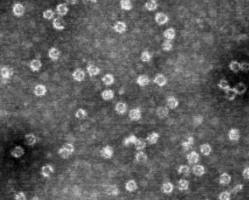

Pursuit of safe drinking water/development and evaluation of new water treatment technologies employing nanoscale particles
The Environmental Risk Engineering Laboratory
| Adsorption with Super-powdered Activated Carbon | Evaluation of norovirus removal by using VLPs |
 |
 |
| Powdered activated carbon is extremely effective in removing odorous substances such as earthy-musty odor compounds. On this account, it is used widely in drinking water treatment plants. However, a long contact time is required for removal. For this reason, when used as a pretreatment step for the membrane treatment, which has started to make inroads in recent years, it cancels out the advantage of this method: namely of being a fast treatment. In this laboratory, we have used rapidly developing nanotechnology to finely pulverize commercially available powdered activated carbon and succeeded in manufacturing super-fine activated carbon that defies conventional wisdom. We are carrying out research to propose high-speed and high-efficiency water treatment methods by using this super-powdered activated carbon (S-PAC). A scanning electron microscope (SEM) image of S-PAC particle is shown above. | Because noroviruses cannot be cultured outside of organisms, the standard flow for microbial treatment experiments—namely large-scale culturing → introduction into experimental apparatus → treatability evaluation—cannot be used. For this reason, currently almost nothing is known regarding the removal of noroviruses during drinking water treatment, which have diameters on the order of 40 nm. In this laboratory we are using genetic recombination techniques to express large quantities of norovirus virus-like particles (VLPs) in silkworms; with these VLPs, we have experimentally investigated, for the first time in the world, the removal of noroviruses during drinking water treatment. |
The Environmental Risk Engineering Laboratory
Division of Environmental Engineering
Graduate School of Engineering
Hokkaido University
N13W8, Sapporo 060-8628, Japan
Members
Projects
Publications
International conferences
Messages